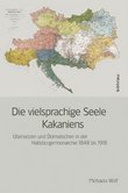Explore

Die Translationswissenschaft der vergangenen Jahre ist durch eine zunehmende interdisziplinäre Auseinandersetzung gekennzeichnet, die der Disziplin zu einer ausgeprägten Profilierung verhalf und vielschichtige wissenschaftstheoretische Diskussionen vorantrieb. Der Beitrag der vorliegenden Arbeit zu dieser Konturierung ist auf mehreren Ebenen zu orten: Zum einen werden, ausgehend von der These, dass das Phänomen der Übersetzung in seinen vielfachen Ausformungen wesentlich zur Konstituierung des plurikulturellen Raumes der Habsburgermonarchie beitrug, verschiedene Schichten des Konstruktcharakters von Übersetzung freigelegt, zum anderen auf der Grundlage des kultursoziologischen Theorierahmens von Pierre Bourdieu die einzelnen Konstruktionsprozesse vor dem Hintergrund detaillierter akteurInnenbezogener Analysen ausgeleuchtet und in die Skizzierung eines „plurikulturellen Kommunikationsraumes der Habsburgermonarchie“ übergeleitet.Zur Bestimmung des Beitrages des übersetzerischen Phänomens zur Konstruktion der habsburgischen Kultur im Untersuchungszeitraum 1848-1918 wird in der postkolonialen Theorie Anleihe genommen und ein Kulturkonzept skizziert, das der auf weite Teile der Monarchie zutreffenden hybriden Befindlichkeit zu entsprechen und die symbolischen Formen ethnisch artikulierter Herrschaft zu erfassen sucht. Unter Anwendung des daraus konzipierten metaphorischen Translationsbegriffs („kulturelle Übersetzung“) wird anschließend auf der Basis der translatorischen Praktiken der Habsburgermonarchie eine Typologie der verschiedenen Übersetzungsformen entworfen, die der Vielschichtigkeit dieser Praktiken entlang der Bandbreite von „Kommunikation“ bis „Translation“ entsprechen. Untersucht wird – vorrangig auf der Grundlage von Archivquellen – zum einen die translatorische Praxis in den Ministerien („Terminologiekommission“, „Redaktionsbureau des Reichsgesetzblattes“, „Sektion für Chiffrewesen und translatorische Arbeiten“), bei Gericht (gerichtliche beeidete Dolmetscher), im diplomatischen Dienst etc., zum anderen werden anhand umfangreicher Korpora die Übersetzungsströme zwischen den einzelnen Sprachen der Kronländer und auch mit Ländern außerhalb der Monarchie nach zahlreichen Parametern aufgearbeitet (Schwerpunkt: Übersetzungen ins Deutsche). Der Fokus dieser letztgenannten Untersuchungen wird schließlich auf die Übersetzungen aus dem Italienischen gelegt, wobei besonderes Augenmerk auf die durch Selektion, Produktion, Distribution und Rezeption dieser Übersetzungen vorgenommenen Konstruktionsprozesse gelegt wird. Der kulturkonstruierende Charakter der Translationspraktiken im habsburgischen Kontext ist an zwei wesentlichen Momenten festzumachen: Zum einen an den nationalitätenbezogenen Spannungen, die allen genannten Translationstypen im Untersuchungszeitraum eingeschrieben sind; zum anderen an der Bi- und Plurilingualität, die, je nach Territorium und jeweiliger gesetzlicher Lage, eine grundsätzliche Voraussetzung für die Übersetzungs- und Dolmetschtätigkeit darstellte und als solche eine professionelle und qualitativ differenzierte translatorische Ausbildung vordergründig nicht erforderlich machte. Dennoch ist eine sukzessiv erfolgende Institutionalisierung der translatorischen Tätigkeit rekonstruierbar.
This book is included in DOAB.
Why read this book? Have your say.
You must be logged in to comment.
